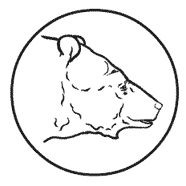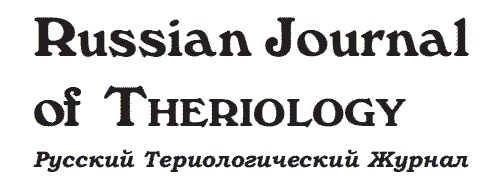Altruism and cooperation in rodents: Insights from analysis of conceptual models and empirical data
Gromov V.S.
P. 49-64
Conceptual models explaining the evolution of altruistic and cooperative behavior, as well as empirical evidence from rodents are reviewed in this article. Alarm calling and helping (alloparental care) are well-known altruistic behaviors in rodents. In behavioral ecology, alloparental care is considered reproductive altruism, which is costly to the actor and benefits the recipient. The evolution of helping is thought to be predicted from the theory of kin selection. Among rodents, however, helping is unlikely to evolve simply through kin selection. A more appropriate explanation is that helping is a by-product of the evolution of sociality (i.e., the transition to a family-group lifestyle). The same applies to the evolution of different cooperative behaviors, most typical of the species living in family groups. Kin selection does not explain the evolution of cooperative behaviors between unrelated individuals, especially in breeding pairs that form family groups. An alternative idea for the evolution of altruistic and cooperative behaviors in rodents is proposed.
DOI: 10.15298/rusjtheriol.24.1.08References- Abbot P., Abe J., Alcock J., Alizon S., Alpedrinha J.A.C., Andersson M., Andre J.-B., van Baalen M., Balloux F. et al. 2011. Inclusive fitness theory and eusociality // Nature. Vol.471. P.e1–e4.
- Ågren G., Zhou Q. & Zhong W. 1989a. Ecology and social behaviour of Mongolian gerbils, Meriones unguiculatus, at Xilinhot, Inner Mongolia, China // Animal Behaviour. Vol.37. P.11–27.
- Ågren G., Zhou Q. & Zhong W. 1989b. Territoriality, cooperation and resource priority: hoarding in the Mongolian gerbils, Meriones unguiculatus // Animal Behaviour. Vol.37. P.28–32.
- Alexander R.D. 1974. The evolution of social behavior // Annual Review of Ecology and Systematics. Vol.5. P.325–383.
- Alexander R.D., Nonan K.M. & Crespi B.J. 1991. The evolution of eusociality // Sherman P.W., Jarvis J.U.M. & Alexander R.D. (eds.). The Biology of the Naked Mole-rat. Princeton: Princeton University Press. P.3–44.
- Allen B., Nowak M.A. & Wilson E.O. 2013. Limitations of inclusive fitness // Proceedings of the National Academy of Sciences of the USA. Vol.110. P.20135–20139.
- Andrews R.V. & Belknap R.W. 1986. Bioenergetic benefits of huddling by deer mice (Peromyscus maniculatus) // Comparative Biochemistry & Physiology, A. Vol.85. P.775–778.
- Armitage K.B. 1981. Sociality as a life-history tactic of ground squirrels // Oecologia (Berlin). Vol.48. P.36–49.
- Armitage K.B. 2007. Evolution of sociality in marmots: It begins with hibernation // Wolff J.O. & Sherman P.W. (eds.). Rodent societies: an ecological & evolutionary perspective. Chicago: University of Chicago Press. P.356–367.
- Arnold W. 1993. Energetics of social hibernation // Carey C., Florant G.L., Wunder B.A. & Boulder H.B. (eds.). Life in the Cold: Ecological, physiological and molecular mechanisms. Colorado: Westview Press. P.65–80.
- Axelrod R. & Hamilton W.D. 1981. The evolution of cooperation // Science. Vol.211. P.1390–1396.
- Baack J.K. & Switzer P.V. 2000. Alarm calls affect foraging behavior in Eastern chipmunks (Tamias striatus, Rodentia: Sciuridae) // Ethology. Vol.106. P.1057–1066.
- Bednekoff P.A. 1997. Mutualism among safe, selfish sentinels: a dynamic game // American Naturalist. Vol.150. P.373–392.
- Bednekoff P.A. & Lima S.L. 1998. Re-examining safety in numbers: interactions between risk dilution and collective detection depend upon predator targeting behavior // Proceedings of the Royal Society, B. Vol.265. P.2021–2026.
- Blumstein D.T. 2007. The evolution of alarm communication in rodents: Structure, function, and the puzzle of apparently altruistic calling // Wolff J.O & Sherman P.W. (eds.). Rodent societies: an ecological & evolutionary perspective. Chicago: University of Chicago Press. P.317–327.
- Blumstein D.T. & Armitage K.B. 1997. Does sociality drive the evolution of communicative complexity? A comparative test with ground-dwelling sciurid alarm calls // American Naturalist. Vol.150. P.179–200.
- Blumstein D.T. & Arnold W. 1998. Ecology and social behavior of golden marmots (Marmota caudata aurea) // Journal of Mammalogy. Vol.79. P.873–886.
- Blumstein D.T. & Daniel J.C. 2004. Yellow-bellied marmots discriminate among the alarm calls of individuals and are more responsive to the calls from pups // Animal Behaviour. Vol.68. P.1257–1265.
- Blumstein D.T., Ebensperger L.A. & Hayes L.D., Vásquez R.A., Ahern T.H., Burger J.R., Dolezal A.G., Dosmann A., González-Mariscal G., Harris B.N., Herrera E.A., Lacey E.A., Mateo J., McGraw L.A., Olazábal D., Ramenofsky M., Rubenstein D.R., Sakhai S.A., Saltzman W., Sainz-Borgo C., Soto-Gamboa M., Stewart M.L., Wey T.W., Wingfield J.C. & Young L.J. 2010. Towards the integrative understanding of social behavior: new models and new opportunities // Frontiers of Behavioral Neuroscience. Vol.4. P.1–9.
- Blumstein D.T., Steinmetz J., Armitage K.B. & Daniel J.C. 1997. Alarm calling in yellow-bellied marmots: II. The importance of direct fitness // Animal Behaviour. Vol.53. P.173–184.
- Bourke A.F.G. 2011. The validity and value of inclusive fitness theory // Proceedings of the Royal Society, B. Vol.278. P.3313–3320.
- Bourke A.F.G. 2014. Hamilton’s rule and the causes of social evolution // Philosophical Transactions of the Royal Society, B. Vol.369. P.20130362–20130362.
- Brady C.A. & Svendsen G.E. 1981. Social behaviour in a family of beaver, Castor canadensis // Biology of Behavior. Vol.6. P.99–114.
- Brown R.Z. 1953. Social behavior, reproduction, and populations changes in the house mouse (Mus musculus L.) // Ecological Monographs. Vol.23. P.217–240.
- Bujalska G. & Saitoh T. 2000. Territoriality and its consequences // Polish Journal of Ecology. Vol.48(Suppl.). P.37–49.
- Burke da Silva K., Kramer D.L. & Weary D.M. 1994. Context-specific alarm calls of the eastern chipmunk, Tamias striatus // Canadian Journal of Zoology. Vol.72. P.1087–1092.
- Busher P. 2007. Social organization and monogamy in the beaver // Wolff J.O & Sherman P.W. (eds.). Rodent societies: an ecological & evolutionary perspective. Chicago: University of Chicago Press. P.280–290.
- Busher P.E., Warner R.J. & Jenkins S.H. 1983. Population density, colony composition, and local movements in two Sierra-Nevadan beaver populations // Journal of Mammalogy. Vol.64. P.314–318.
- Calhoun J.B. 1963. The ecology and sociology of the Norway rat. Public Health Service Publication, No.1008. Washington: Department of Health, Education and Welfare. 288 p.
- Charnov E.L. 1977. An elementary treatment of the genetical theory of kin selection // Journal of Theoretical Biology. Vol.66. P.541–550.
- Charnov E.L. & Finerty J.P. 1980. Vole population cycles: A case for kin selection? // Oecologia. Vol.45. P.1–2.
- Charnov E.L. & Krebs J.R. 1975. The evolution of alarm calls: Altruism or manipulation? // American Naturalist. Vol.109. P.107–112.
- Clutton-Brock T.H. 2002. Breeding together: kin selection and mutualism in cooperative vertebrates // Science. Vol.296. P.69–72.
- Clutton-Brock T.H. 2009. Cooperation between non-kin in animal societies // Nature. Vol.462. P.51–57.
- Corbet N.U. & van Aarde R.J. 1996. Social organization and space use in the Cape porcupine in a southern African savanna // African Journal of Ecology. Vol.34. P.1–14.
- Davies N.B., Krebs J.R. & West S.A. 2012. An introduction to behavioural ecology. 4th ed. Oxford: Blackwell Scientific. 586 p.
- Davis L.S. 1984. Alarm calling in Richardson’s ground squirrels (Spermophilus richardsonii) // Zeitschrift für Tierpsychologie. Bd.66. S.152–164.
- Dezhkin V.V., D’jakov Y.V. & Safonov V.G. 1986. [The castor.] Moscow: Agropromizdat. 256 p. [in Russian].
- Dunford C. 1977. Kin selection for ground squirrel alarm calls // American Naturalist. Vol.111. P.782–785.
- Ebensperger L.A. & Bozinovic F. 2000. Communal burrowing in the hystricognath rodent, Octodon degus: A benefit of sociality? // Behavioral Ecology and Sociobiology. Vol.47. P.365–369.
- Ebensperger L.A. & Hayes L.D. 2016. Causes and evolution of group-living // Ebensperger L.A. & Hayes L.D. (eds.). Sociobiology of Caviomorph Rodents: An Integrative Approach, First Edition. New York: John Wiley & Sons. P.173–200.
- Ebensperger L.A., Hurtado M., Soto-Gamboa M., Lacey E. & Chang A. 2004. Communal nesting and kinship in degus (Octodon degus) // Naturwissenschaften. Vol.91. P.391–395.
- Ebensperger L.A., Hurtado M. & León C. 2007. An experimental examination of the consequences of communal versus solitary breeding on maternal condition and the early postnatal growth and survival of degu, Octodon degus, pups // Animal Behaviour. Vol.73. P.185–194.
- Ebensperger L.A., Ramírez-Estrada J., León C., Castro R.A., Tolhuysen L.O., Sobrero R., Quirici V., Burger J.R., Soto-Gamboa M. & Hayes L.D. 2011. Sociality, glucocorticoids and direct fitness in the communally rearing rodent, Octodon degus // Hormones and Behavior. Vol.60. P.346–352.
- Emlen S.T. 1991. Evolution of cooperative breeding in birds and mammals // Krebs J.R. & Davies N.B. (eds.). Behavioural ecology: An evolutionary approach. London: Blackwell Scientific. P.301–335.
- Emlen S.T., Reeve H.K., Sherman P.W., Wrege P.H., Ratnieks F.L.W. & Shellman-Reeve J. 1991. Adaptive versus nonadaptive explanations of behavior: the case of alloparental helping // American Naturalist. Vol.138. P.259–270.
- Frank S.A. 2003. Repression of competition and the evolution of cooperation // Evolution. Vol.57. P.693–705.
- Frank S.A. 2013. Natural selection. VII. History and interpretation of kin selection theory // Journal of Evolutionary Biology. Vol.26. P.1151–1184.
- French J.A. 1994. Alloparents in the Mongolian gerbil: impact on long-term reproductive performance of breeders and opportunities for independent reproduction // Behavioral Ecology. Vol.5. P.273–279.
- Galef B.G. & Wigmore S.W. 1983. Transfer of information concerning distant foods: a laboratory investigation of the “information centre hypothesis” // Animal Behaviour. Vol.31. P.748–758.
- Gardner A., Griffin A.S. & West S.A. 2010. Altruism and cooperation // Westneat D.F. & Fox C.W. (eds.). Evolutionary Behavioral Ecology. New York: Oxford University Press. P.308–326.
- Garson P.J. 1975. Social interactions of wood mice (Apodemus sylvaticus) studied by direct observation in the wild // Journal of Zoology. Vol.177. P.496–500.
- Getz L.L. & Carter C.S. 1980. Social organization in Microtus ochrogaster populations // The Biologist. Vol.62. P.56–69.
- Getz L.L. & Hofmann J.E. 1986. Social organization in free-living prairie voles, Microtus ochrogaster // Behavioral Ecology and Sociobiology. Vol.18. P.275–282.
- Getz L.L., McGuire B., Pizzuto T., Hofmann J.E. & Frase B. 1993. Social organization of the prairie vole (Microtus ochrogaster) // Journal of Mammalogy. Vol.74. P.44–58.
- Grafen A. 1984. Natural selection, kin selection, and group selection // Krebs J.R. & Davies N.B. (eds.). Behavioral Ecology. An Evolutionary Approach. Oxford: Blackwell Scientific. P.62–84.
- Gromov V.S. 2000. [Ethological mechanisms of population homeostasis in gerbils (Mammalia, Rodentia)]. Moscow: IPEE Press. 216 p. [in Russian].
- Gromov V.S. 2005. Parental care in captive Brandt’s vole (Lasiopodomys brandti) // Russian Journal of Theriology. Vol.4. No.1. P.137–145.
- Gromov V.S. 2007. Parental care in captive social voles Microtus socialis // Zoologicheski Zhurnal. Vol.86. No.11. P.1389–1397 [in Russian].
- Gromov V.S. 2008. [The spatial-and-ethological population structure in rodents]. Moscow: KMK Scientific Press. 586 p. [in Russian].
- Gromov V.S. 2010. Interactions in family pairs and parental care in captive steppe lemming (Lagurus lagurus) // Contemporary Problems of Ecology. Vol.3. No.1. P.1–7.
- Gromov V.S. 2011. Biparental care, tactile stimulation, and evolution of sociality in rodents // Journal of Evolutionary Biology Research. Vol.3. P.33–43.
- Gromov V.S. 2013. Care of young and the effect of the presence of a male on parental behavior of the common vole (Microtus arvalis) in captivity // Contemporary Problems of Ecology. Vol.6. No.3. P.330–335.
- Gromov V.S. 2017. The spatial-and-ethological population structure, cooperation, and the evolution of sociality in rodents // Behaviour. Vol.154. P.609–649.
- Gromov V.S. 2018. The evolution of sociality in rodents: Environments and selective forces promoting grouping. Mauritius: Lap Lambert Academic Publishing. 163 p.
- Gromov V.S. 2020. Epigenetic programming of phenotypic differences in behaviour and the evolution of sociality in rodents // Biology Bulletin Reviews. Vol.10. No.4. P.338–350.
- Gromov V.S. 2021. Relationship between the social structure and potential reproductive success in muroid rodents // Biology Bulletin. Vol.48. P.1740–1746.
- Gromov V.S. 2022. Ecology and social behaviour of the Mongolian gerbil: A generalised review // Behaviour. Vol.159. P.403–441.
- Gromov V.S. 2023a. Alloparental care in social muroid rodents // Russian Journal of Theriology. Vol.22. No.2. P.150–161.
- Gromov V.S. 2023b. Ecology and social behaviour of the social vole Microtus socialis: A generalized review // Current Zoology. Vol.69. P.775–783.
- Gromov V.S. 2023c. Ecology and social behavior of the Brandt’s vole: A generalized review // Journal of Arid Environment. Vol.214. P.e104994. doi: 10.1016/j.jaridenv.2023.104994
Download PDF
|

